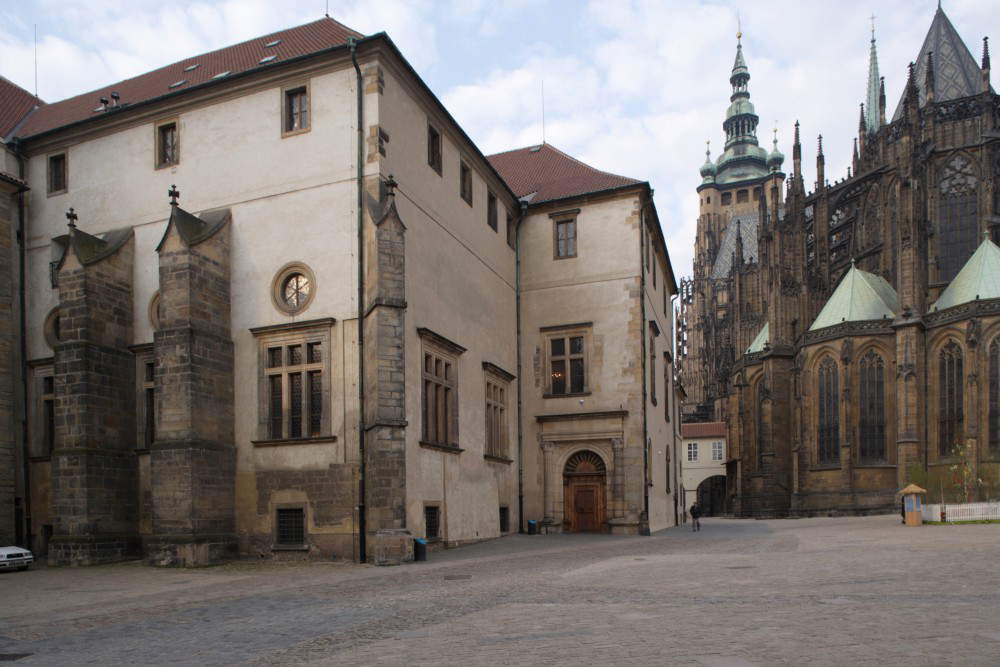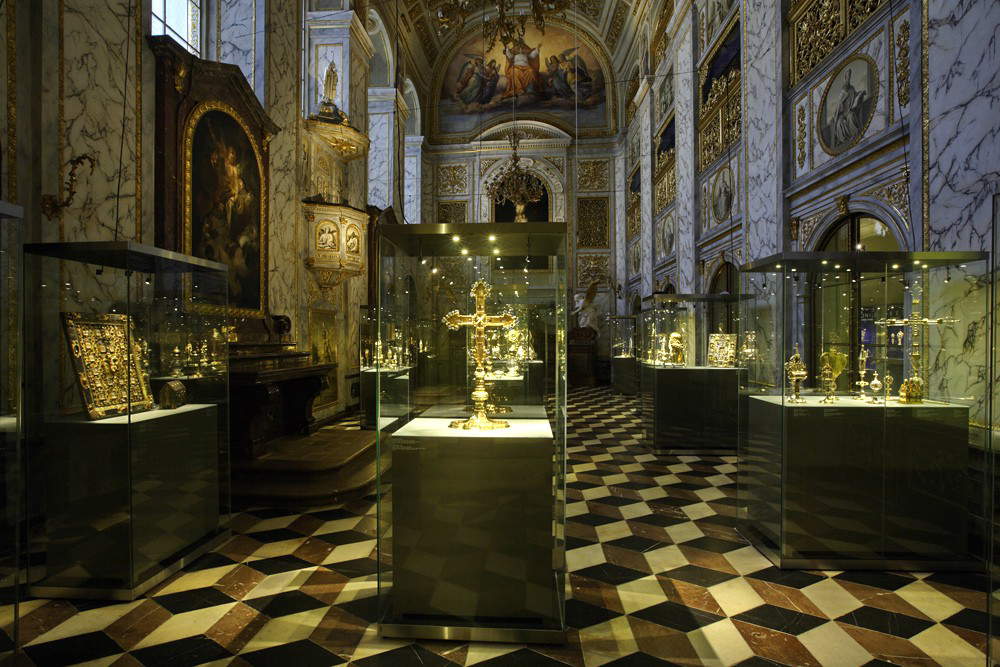In Czech it is called Pražský Hrad: in Italian, more simply, it is Prague Castle, the fortified complex that, since the 9th century, has dominated the capital of the Czech Republic from above. The most well-known peculiarity, as well as the main boast of this monument, is the fact that Prague Castle is one of the largest in the world (according to Guinness World Records it would even be the largest castle in the world ever), developing over an area of 70 thousand square meters. But it is not only one of the most popular sites for tourists who flock to Prague every year: in fact, it is also a relevant cultural institution as well as a symbol of the nation, since today it is the official residence of the president of the Czech Republic. Today, it stands as a monumental complex in different styles that tell of its long history, starting from the Middle Ages and reaching to the present day: also included within it is the Prague Cathedral, namely St. Vitus Cathedral.
The history of Pražský Hrad begins in all probability around the year 880: the foundation is perhaps due to Prince Bořivoj, of the Premyslid dynasty, who on this hill, 570 meters above sea level, built the first building, a church dedicated to the Virgin, around which a fortified complex developed. Shortly afterwards, King Wenceslas I, in 920, built another church, the Basilica of St. George, which today is the oldest building of those inside the Castle (though remodeled in later centuries), and a decade later also the Cathedral of St. Vitus, destined to become the city’s most important church. The cathedral stands today in the arrangement it was given in the 14th century, albeit with 19th-century makeovers (in which the celebrated painter Alfons Mucha, who worked on the stained-glass windows, also participated): a soaring Gothic monument, with its imposing and very tall three naves (inside, moreover, are the sepulchres of the kings of Bohemia, and the tombs of St. Wenceslas, the nation’s patron saint, and St. John of Nepomuk), it is shown with its two 82-meter-high facade towers and a bell tower that instead exceeds 100 meters in height (102.8 to be precise).
It was during the reign of Ottokar II of Bohemia in the mid-13th century that the castle was expanded to become a splendid seat of power for the kings of Bohemia. Soon after, Charles IV had the Royal Palace rebuilt in the Gothic style and strengthened the fortifications. Prague Castle, meanwhile, was preparing to witness important historical events: the Hussite crusade (during which the Castle was abandoned), the rise of the Habsburgs who had several buildings rebuilt in the Renaissance style and brought many works of art there, and then again the famous Defenestration of Prague in 1618, considered the event that started the Thirty Years’ War (it was from a window of Prague Castle that the two imperial governors and their secretary were thrown by the rioting aristocrats: None, however, had serious consequences, given the low height of the windows and the presence of sloping ground that ensured a... soft landing). By the seventeenth century the castle had attained its present appearance: the last major works were those promoted by Empress Maria Theresa in the second half of the eighteenth century. It became the official residence of the Czech president in 1918, and was occupied by the Nazis in 1939, who made it the home of the infamous Nazi hierarch Reinhard Heydrich, Protector of Bohemia and Moravia, who was killed in 1942 during Operation Anthropoid, the most famous act of the Czech Resistance (the Operation took place a short distance from the Castle). In 1948, after the Coup d’état, the Castle became the seat of the government of Czechoslovakia, and returned to be the residence of the president of the Czech Republic in 1993, after the division of the Czech Republic from Slovakia.
 |
| Prague Castle |
 |
| St. Vitus Cathedral |
 |
| The Old Royal Palace |
 |
| The Picture Gallery |
 |
| The Treasury of the Cathedral |
 |
| The Golden Alley |
Prague Castle today is a monument that preserves bodies in different styles: from Gothic to Baroque, Renaissance to Neo-Gothic. And there are many buildings that can be visited inside. There are four churches: the Cathedral, the Basilica of St. George (with adjoining convent), the Church of All Saints, and the Chapel of the Holy Cross. And then, the palaces: the Old and the New Royal Palace, the Summer Palace of Queen Anne, also known as the “Belvedere,” the Lobkowicz Palace, the towers, the very famous Golden Lane, or the string of eleven small colorful buildings, dating back to the 16th century, which originally housed the quarters of the guards of Rudolph II of Habsburg (the name is due to the fact that it was later inhabited by goldsmiths: according to one legend, moreover, alchemists supposedly lived here, trying to find, for Rudolph II, a way to turn iron into gold). And then, the gardens: the Royal Castle Garden, the Orangery, the Bastion Garden, the Southern Gardens, St. Wenceslas Vineyard, and the Deer Pit.
Inside the Castle buildings (much of which can be visited) there are also three permanent exhibitions. The best known is the Treasury of St. Vitus Cathedral, one of the largest collections of sacred art in Europe, which originates from the chapel built in 929 by Prince Wenceslas to house the relic of the arm of St. Vitus. The Treasury has suffered loss and damage over the centuries (beginning with those suffered during the Hussite war), but many precious objects (from reliquaries to goldsmiths’ items, from paintings to the textile collection) have remained and constitute today, as mentioned, one of the largest collections of sacred furnishings on the continent. Instead, the permanent exhibition on the History of the Castle, housed in the Gothic hall of the Old Palace, opened in 2004. It is divided into two parts: the first, through a rich collection of objects, tells the story of Pražský Hrad, while the second is an itinerary through topics related to the Castle’s history: the history of the patrons of the Czech Republic, the history of the cathedral, and so on.
Finally, the Castle also houses a remarkable Picture Gallery, which has its roots in the time when Rudolf II of Habsburg (the Holy Roman Emperor who, in 1583, decided to move the capital of the empire from Vienna to Prague) settled in the Castle, expanding it considerably and bringing in a large number of works of art. It is estimated that already at the time of Rudolf II, the Castle housed about three thousand works of art, including masterpieces by Italian, Dutch and German masters, many of which, however, did not remain in Prague: many, already with Rudolf II’s successor, Matthias, took the road to Vienna. So many more, however, were looted in 1630 during the siege of Prague. Still others were taken away by the Swedes in 1648. In essence, by the mid-seventeenth century the rooms of the Castle were almost empty, until Emperor Ferdinand III returned to fill them, thanks to the purchase of part of Lord Buckingham’s collection. It was the beginning of a new life: many more works then continued to leave the castle (often still in the direction of Vienna-a flow that did not stop until the early 20th century), but many remained, and today the Picture Gallery is still one of the largest picture galleries in the country, with works by Titian, Rubens, and other notable artists.
Visited by nearly two million people each year, Prague Castle is one of the most popular sights for visitors to the Czech capital, so it is advisable to get a ticket in advance. The Castle, moreover, is also a venue for exhibitions, events, concerts, as well as, of course, official ceremonies.
 |
| Prague Castle, the ancient complex that is among the largest castles in the world |
Warning: the translation into English of the original Italian article was created using automatic tools. We undertake to review all articles, but we do not guarantee the total absence of inaccuracies in the translation due to the program. You can find the original by clicking on the ITA button. If you find any mistake,please contact us.